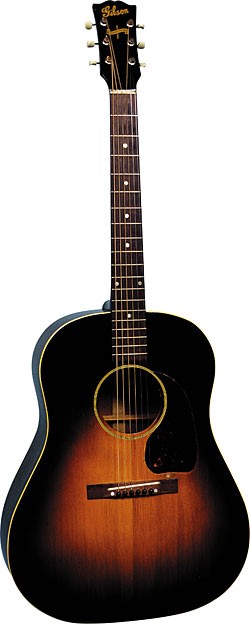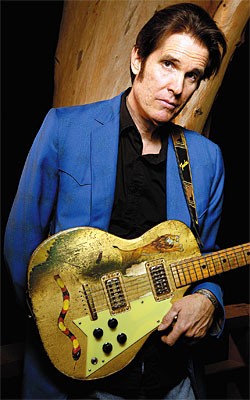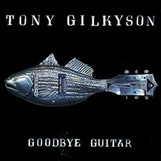
Gibson J-45
The J-45 is seldom mentioned in the context of such Gibson classics as the Super 400, ES-335, Flying V, Les Paul Standard, F-5 mandolin and Mastertone banjos. And even among its fellow flat-tops, it doesn’t have anywhere near the notoriety of Gibson’s J-200 and Advanced Jumbo. But the J-45 has been, by the company’s own description, the “workhorse guitar” of Gibson’s flat-top family since its introduction during World War II. And it’s a deserving new inductee to the VG Hall of Fame.
The J-45 is Gibson’s basic mahogany-body dreadnought, the Gibson equivalent to Martin’s D-18. However, the J-45 wasn’t introduced until a decade after the first dreadnoughts appeared under the Martin brand. Gibson’s initial answer to Martin’s D-sizes of 1931 was the Jumbo model of 1934, easily distinguished from other dreadnoughts – Gibson’s as well as Martin’s – by its body depth, which remained over 4″ deep from endpin to neck heel. It featured a slightly larger body than a Martin; the Martins checked in (officially) at 15 5/8″ wide and just under 20″ long, while the Gibson was a full 16″ wide and 20″ long. The outline of the two competing dreadnoughts was noticeably different: squarish upper bouts on the Martins compared to more rounded “shoulders” on the Gibson. The round-shouldered Gibson shape actually pre-dated the D-18 (initially named D-1), having been used on Gibson’s oddball HG-24 as early as 1929. However, it first appeared on the 12-fret, round-shouldered dreadnoughts Martin had made for the Ditson company beginning in 1916. In any case, the square-shouldered Martin and the round-shouldered Gibson endure and compete as the signature dreadnought shapes of their respective companies to this day.
While Martin considered its design changes minor enough that the company never changed the name of the D-18, Gibson revamped its mahogany-body dreadnought several times in the ’30s, renaming it each time. The Trojan, whose run was so brief in late 1936 that it never appeared in a catalog, had the Jumbo’s uniform-depth body but had a narrower “French” neck heel, a silkscreened logo, and no back binding (compared to the Jumbo’s pearl logo and bound back). Next came the J-35, named for its original price of $35; it featured a more conventional body depth that tapered noticeably from about 4 3/4″ at the endpin to about 3 3/4″ at the neck heel.
The J-35 did quite well, more than doubling the sales of all other large-body flat-top Gibsons combined. In 1941, Gibson added a natural-finish option. But just a year later, it abandoned the J-35 for a new model. It was wartime and Gibson was cutting back guitar production and retooling for war products. The J-45, as the new model would be called, looked just like the J-35 except for its pickguard and wartime peghead logo. The bracing was a little heavier, but it could just as easily been a continuation of the J-35. Maybe Gibson thought a new model name was necessary to spur sales.
The exact date of the first J-45 is uncertain. The first entry in Gibson’s shipping ledgers is August 17, 1942, and the reason for the uncertainty is the listing of a handful of J-50s starting six weeks earlier, on July 7. The J-50 would be the natural-top version of the J-45 and would have a triple-bound rather than a single-bound top; however, there are some early J-45 examples with the triple-bound top (a spec that would not be standard until 1950), so the first J-50s could be J-45s. Or Gibson could simply have been uncertain about where to price the new model – $45 or $50. Curiously, the J-50 does not reappear in the ledger books for more than two years.
The J-45, as the only large-bodied Gibson flat-top produced through most of the war years, was quite successful. It changed specs from time to time during the war, undoubtedly as a result of Gibson’s material shortages. Some examples had a mahogany top, some had maple back and sides, some had no truss rod in the neck, but all had the “Only a Gibson Is Good Enough” banner on the peghead.
After the war, the J-45 and J-50 prospered but eventually fell victim to the sort of design tinkering that destroyed most of Gibson’s classic models from the Ted McCarty era (1948-’65). The bridge had started with a Martin-style “design,” then gone to a rectangular shape, then back to a belly style in ’46 before going to Gibson’s “upper belly” style in ’49. The top received three-ply binding by 1950. In ’55, the Martin-style teardrop pickguard was replaced by a larger guard with a point near the widest part of the upper bout.
Then the changes became more serious. In ’56 Gibson introduced an optional height-adjustable saddle that, in the opinion of most players, sabotaged the connection between the bridge and the top of the guitar. It became a standard feature in 1960. Circa ’61, the bridge was further compromised by the introduction of a plastic bridge. A Cherry sunburst finish, introduced in ’62, did not affect the guitar’s performance, of course, but it distanced the J-45 from Gibson tradition.
In ’69, the Martin-style belly bridge returned, and turned out to be a signal of a fundamental change in the J-45s design. Late in that year, Gibson abandoned the round-shouldered dreadnought shape and gave the J-45 a Martin-style square-shouldered body, along with a longer, 25.5″ scale length. The assault on the J-45 continued in 1970 with the tone-killing double-X bracing pattern (although Gibson did do away with the height-adjustable saddle). The binding changed by ’75 with the addition of a tortoiseshell (plastic) outer layer. In the mid ’70s Gibson labels called it the J-45 Deluxe, and in ’76 it was lumped together with the J-50 as the J-45/50 model.
Throughout all of these indignities, J-45 sales remained strong. In the ’50s it easily outsold every other flat-top except the low-priced, small-body LG-1. In the ’60s it was surpassed only by the even lower-priced all-mahogany LG-0. In the ’70s, as Gibson’s small-body flat-tops fell out of favor and eventually out of production, only the J-50 outsold the J-45.
Starting in ’76, annual sales of the J-45 fell below 1,000 for the first time ever, and dropped lower with each passing year. By ’82, the model was a far cry from its original form and Gibson called a halt to its progressive degeneration by discontinuing it. In retrospect it appears to have only been a “temporarily closed for renovation” situation. The J-45 has never been included in the wave of early-’80s vintage reissues like the Cherry sunburst Les Paul, the korina Flying V and Explorer, and the dot-neck ES-335. But it returned, nevertheless, in ’84, looking very much like the early-’50s version with a round-shouldered body, upper-belly bridge and teardrop pickguard.
Gibson toyed with the J-45 a little more, calling it the J-45 Western and adding the wartime “Only a Gibson…” banner in ’94, then removing the banner and calling it the Early J-45 from 1997-’98. In the meantime, it spawned at least 10 variations with upgraded ornamentation or woods beginning with the J-45 Celebrity in ’85.
Since 1999, the J-45 has looked like the quintessential model, with round shoulders, a teardrop pickguard, and post-war decal logo. Now offered with a pickup and unobtrusive soundhole-mounted controls, it remains a “core model” in Gibson’s flat-top line.
This article originally appeared in VG‘s March 2008 issue. All copyrights are by the author and Vintage Guitar magazine. Unauthorized replication or use is strictly prohibited.



